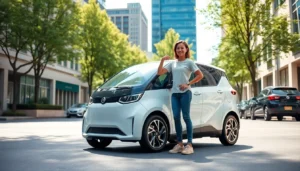In a world where range anxiety feels like the new “Are we there yet?” electric car enthusiasts are on a quest for the ultimate travel companion. Enter the electric car range comparison chart—a handy guide that promises to take the guesswork out of your next road trip. With so many options zipping around, it’s crucial to know which electric vehicle can take you further without needing a coffee break at every charging station.
Overview of Electric Car Ranges
Electric car ranges vary significantly depending on the model and technology used. Current electric vehicles (EVs) can achieve ranges from 100 miles to over 400 miles on a single charge. Tesla models typically lead in range, with the Model S offering around 405 miles of range, making it a popular choice for long-distance drivers.
Other manufacturers also present competitive options. The Ford Mustang Mach-E ranges between 211 miles and 300 miles, based on the battery selection. Nissan’s Leaf offers a distance of up to 226 miles, appealing to daily commuters.
Charging infrastructure influences effective range too. Locations with fast-charging stations can reduce time spent on road trips, enabling drivers to travel longer distances without lengthy stops.
Understanding the average range of electric cars helps anticipate travel times. For instance, a trip covering 250 miles would require planning for a charging stop if driving a vehicle with a range of only 200 miles.
The table below summarizes the range of popular electric vehicles.
| Electric Vehicle | Range (miles) |
|---|---|
| Tesla Model S | 405 |
| Ford Mustang Mach-E | 211 – 300 |
| Nissan Leaf | 226 |
| Chevrolet Bolt EV | 259 |
| Hyundai Kona Electric | 258 |
| Audi e-tron | 222 |
Data indicates that as battery technology advances, ranges will increase, expanding the appeal of electric cars. Keeping track of these developments aids potential buyers in making informed decisions regarding their next vehicle purchase.
Factors Affecting Electric Car Ranges
Several factors influence the range of electric vehicles. Understanding these elements helps consumers make informed decisions.
Battery Capacity
Battery capacity determines how far an electric car can travel on a single charge. Larger batteries typically provide longer ranges, with options varying from 40 kWh in smaller models to over 100 kWh in premium vehicles like the Tesla Model S. Higher capacity directly correlates with increased mileage, meaning a vehicle with a 75 kWh battery can achieve over 300 miles under ideal conditions. Efficient battery management systems optimize energy usage, enhancing overall range performance and user satisfaction.
Driving Conditions
Driving conditions dramatically affect electric vehicle ranges. Frequent acceleration and deceleration in urban settings may reduce mileage compared to steady highway driving. Terrain also plays a critical role; uphill routes consume more energy, while downhill driving can regenerate some power through regenerative braking. Maintaining a consistent speed and avoiding aggressive driving helps maximize efficiency and extends overall range.
Climate Impact
Climate impacts range performance significantly for electric cars. Cold temperatures can decrease battery efficiency, often reducing driving ranges by 20% or more. In contrast, extreme heat can affect battery chemistry, leading to accelerated degradation. Using climate control systems further drains battery power, making it vital for drivers to consider seasonal changes and plan accordingly. Proper vehicle conditioning and pre-heating or pre-cooling the cabin while plugged in can help mitigate these effects.
Popular Electric Cars in the Market
Electric cars vary significantly in range, attracting different consumers based on their needs. Here’s a look at some popular models.
Tesla Model Comparison
Tesla offers several models with impressive ranges. The Model S stands out with a range of approximately 405 miles, making it ideal for long trips. Model 3, with its Standard Range Plus, delivers about 263 miles on a single charge. Model X, the SUV variant, provides around 348 miles, while Model Y offers a range near 326 miles. Each model incorporates advanced technology, enhancing efficiency and performance on the road.
Nissan Leaf Range Insights
Nissan Leaf has carved a niche in the electric vehicle space. The standard version achieves about 150 miles per charge, suitable for city driving. For those seeking more range, the Leaf Plus model extends the distance to approximately 226 miles. Both models focus on practicality, making them ideal for daily commuters and urban environments. Users appreciate the Leaf’s affordability alongside its range capabilities.
Ford Mustang Mach-E Overview
Ford’s Mustang Mach-E blends performance with electric efficiency. The Extended Range version boasts around 300 miles, appealing to those who value power and distance. Different battery options allow for customized range, catering to diverse driving habits. Styling cues from traditional Mustangs also attract buyers who desire a sporty aesthetic. This model stands out in a crowded field, merging functionality with innovative design.
Electric Car Range Comparison Chart Analysis
Electric car ranges vary significantly among models. The Tesla Model S leads the market, offering around 405 miles on a single charge. Other Tesla models also provide impressive ranges: the Model 3 reaches approximately 263 miles, while the Model X offers about 348 miles and the Model Y achieves around 326 miles. Among non-Tesla options, the Ford Mustang Mach-E supports those seeking both performance and range, with its Extended Range version providing about 300 miles.
The Nissan Leaf presents practicality for urban environments with the standard version achieving around 150 miles and the Leaf Plus reaching 226 miles. The Chevrolet Bolt EV and Hyundai Kona Electric also contribute competitive ranges, appealing to different consumer preferences.
Factors influencing electric vehicle ranges include battery capacity, driving conditions, and climate. Larger batteries, like a 75 kWh model, typically yield over 300 miles under optimal circumstances. Urban driving generally results in shorter ranges than highway driving due to frequent stops and starts.
Weather conditions also play a critical role. Cold temperatures may reduce battery efficiency by up to 20%, while heat can degrade battery life. Implementing vehicle conditioning can help mitigate these effects, enhancing overall performance.
In a comparison chart, consumers can easily assess these details, allowing for informed decisions regarding electric vehicle purchases. Understanding specific ranges helps minimize charging stops during road trips and addresses concerns about range anxiety effectively.
Future Trends in Electric Car Ranges
Emerging technology plays a crucial role in the development of electric vehicle ranges. Many manufacturers focus on enhancing battery chemistry by utilizing advanced lithium-ion and solid-state technology, aiming to improve energy density. Tesla continues to lead with innovations, such as the introduction of new battery architectures in their future models.
In addition, manufacturers are investing in charging infrastructure, intending to provide faster charging solutions. Superchargers can already replenish battery capacity at impressive rates, and these advancements could reduce charging times even further, enhancing convenience for drivers. The partnership between automakers and charging network companies aims to expand accessibility.
Consumer demand drives the push for longer ranges, influencing manufacturers to prioritize range improvement. Competitors like Ford, GM, and Volkswagen are developing electric models with ranges projected to exceed 400 miles. Buyers increasingly seek vehicles offering significant distances, facilitating longer road trips without frequent charging breaks.
Additionally, government regulations and incentives encourage the dream of an all-electric future. Many regions set ambitious emissions targets that stimulate research and development for more efficient electric vehicles. As regulation further shapes the market, manufacturers adapt their products to meet consumer demands and environmental standards.
Autonomous driving features also contribute to range advancements. Improved aerodynamics and energy-efficient driving patterns could extend vehicle ranges, making long trips more manageable. As technology continues to evolve, real-world testing provides insights into actual performance under varying conditions.
Ultimately, trends indicate a promising future for electric vehicle ranges. Advancements in technology, infrastructure, and regulations will shape the electrification of transportation, addressing range anxiety and aligning with consumer preferences.
The electric car range comparison chart serves as an essential resource for anyone considering an electric vehicle. By understanding the varying ranges of different models and the factors that influence them, consumers can make better-informed choices.
As technology continues to evolve electric vehicles are becoming more efficient and capable of longer distances. With advancements in battery technology and charging infrastructure the future looks bright for long-distance electric driving.
Choosing the right electric vehicle can significantly reduce range anxiety and enhance the overall driving experience. By leveraging available information drivers can confidently embark on their journeys knowing they’ve made the best choice for their needs.





